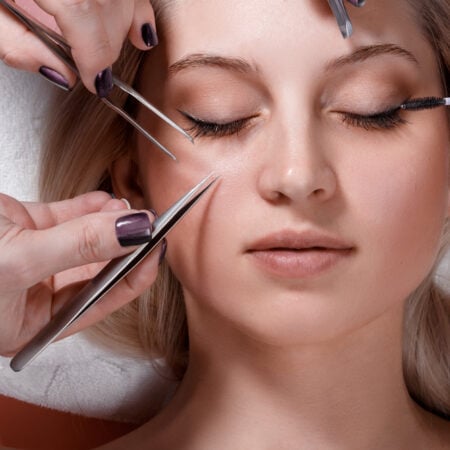Esthetics is a branch of the health and wellness industry that focuses on skincare. It can also be spelled as aesthetics, but don’t mix it up with the branch of philosophy appreciating beauty (although they have the same name).
The work of estheticians is varied — it can involve microdermabrasion, spa treatments, masks, facials, waxing, massages, and more. Professionals may also learn more advanced treatments, like lasering and permanent hair removal.
In general, estheticians carry out all kinds of treatments that improve or maintain skin’s health and appearance on the face and body.
Although it’s possible to train as an esthetician by taking part in a general cosmetology course, it makes sense to enroll in a specific esthetician training program if you already know what you want to do. This can also be a good route to other beauty-related careers.
If all this sounds like your sort of thing, there’s good news — chances are, there’s an esthetics school near you that offers everything you want and more. Use the school finder below to find the program of your dreams.
What to Look for When Choosing an Esthetician Training Program?
Picking the wrong esthetician training program could be the difference between making an effortless transition to becoming a successful esthetician and struggling to get into the job market at all. It’s not a decision to take lightly.
Yet with every school under the sun singing its own praises through fancy marketing materials, it can be hard to tell which programs genuinely have the most to offer. Here are a few factors to keep in mind.
Licensing Assistance
Estheticians have intimate access to their clients’ skin — if they don’t know what they’re doing, they could give their clients infections or other skin problems. As well as knowing the glamorous stuff, they must be able to understand skin histology, infection control procedures, sanitation, and how the entire integumentary system works.
It therefore shouldn’t come as a surprise that licensing is highly important.
All states (with the exception of Connecticut) require estheticians to pass an examination and receive licensing through their local health department or their state’s Board of Cosmetology. All states follow the same general process, although the examination works slightly differently between states.
When comparing esthetician training programs, make sure you choose a school that stays updated with its licensing board’s latest developments and requirements. There’s no use completing training that won’t even help you qualify as an esthetician!
Accreditation
One of the best ways to tell whether a program is likely to provide a high-quality education and help you pass the state licensing exam is figuring out whether it’s an accredited institution.
The main accrediting agency in the United States is the National Accrediting Commission of Career Arts & Sciences — it’s the largest in the country, and has accredited hundreds of esthetician training programs.
The Council on Occupational Education and the Accrediting of Career Schools and Colleges are two other legitimate agencies to consider, although they don’t carry quite the same weight in the industry.
This doesn’t mean that all accredited schools are automatically superior to all non-accredited schools. In some cases, a school might prefer to remain unassociated with accrediting agencies for its own reasons. But, as a rule of thumb, it’s almost always better to opt for an accredited program (given the choice).
Job Prospects
The whole point of attending esthetician training is to land yourself a great job. Although going through an accredited program that helps you with licensing is the most important factor in securing this end, it’s not the only thing to consider.
Some schools put a lot more thought and effort into how much they help their students find a job afterward. The best schools should actively be boosting the employability of their students by offering networking events, links with local businesses for work experience, or even mentoring opportunities with successful alumni.
Teaching Quality
Even if a school ticks all the boxes for what a good esthetician program needs in theory — like accreditation and great equipment — it doesn’t guarantee a great learning experience.
To help you gauge the teaching quality, you need to consider other metrics. Ask about the teachers’ credentials and work experience and how long they’ve worked at the school. If most of the staff have only been there for a few months and have limited experience, it’s a sign something is wrong.
Another figure to consider is the dropout rate — ideally, 90% or more of students should graduate from the program.
It can also be helpful to read as many reviews of the school as you can find, as this can be one of the only ways of actually seeing real student testimonials.
Cost
Of course, anyone hoping to go through esthetician training wants to attend the best program possible. But you also have to be practical — make sure you choose a school at a reasonable cost and with good scholarships available.
To help you out, we’ll delve into the costs and financial aid in more detail next.
How Much Does Esthetician Training Cost?

Esthetician training isn’t as expensive as attending a traditional college, but it could still take you back a few hundred to a few thousand dollars. So, make sure that the earning potential a program offers is worth its price tag!
Locations
There’s a huge variation in the cost of esthetician training programs depending on where they take place. Big cities (like New York and Los Angeles) tend to be the most expensive, while rural areas often charge lower fees.
Rather than just choosing the cheapest school, though, you should weigh up the costs and benefits of a training program carefully. Just because a particular city has a more expensive program, it doesn’t necessarily mean that you should give it a miss. Big cities might set you back more to begin with, but they often have better industry links and employment opportunities (of course, don’t just assume this is the case without checking).
Also, certain programs may work out cheaper for you if you’re eligible for scholarships or have access to low-cost accommodation.
Scholarships and Financial Aid
As touched on already, scholarships and financial aid can make a huge difference in how feasible it is for you to participate in a training program. Fortunately, because of the demand for estheticians currently, there’s lots of aid available.
Firstly, there’s a range of state, national, and international scholarships available for any esthetics students training at accredited institutions. There’s a comprehensive list of accredited esthetics schools here.
Then there are the scholarships that an individual school offers. In some cases, if a school has successful alumni who want to help upcoming talent to be successful, they might offer support packages to help them through their studies. When comparing different schools and programs, be sure to ask the admissions office about any scholarships they offer.
Also, some esthetician training programs might make you eligible for federal financial aid, just like other college programs. As long as the institution is accredited, you should qualify for Title IV federal financial funding — this would make you eligible for the Federal Pell Grant, Federal Perkins Loan, and Federal Supplemental Educational Opportunity Grant (SEOG).
Most people only consider the fees for the actual training program, but this is far from the only cost you’ll incur when studying.
Esthetics is a practical program that involves lots of equipment. Although good schools should provide advanced equipment (like fancy machines and lights), you’ll need to buy the basics for yourself — such as eye protection, brushes, and gloves.
You’re also likely to need textbooks along the way, because esthetics training involves learning the theory of skincare and hygiene. Although some schools might have a good library or secondhand market, it’s hard to get out of buying textbooks altogether.
Expect to spend a few hundred, or even thousands, dollars throughout the program. Still, these aren’t exactly sunk costs — you may be able to sell your textbooks on and continue to use your equipment when you start practicing.
How Long Does Esthetician Training Take?
The average esthetician training program takes 600 hours of training, but it can vary widely depending on factors like how and where you study.
Differences Between States
Although the average esthetics program takes 600 hours, every state has different licensing requirements regarding how long you need to train. And you might be surprised by just how different they can be!
The states with the shortest requirements ask for just 300 hours of training, while others can ask for up to 1,000 hours. This could make the difference between qualifying in under six months and over a year.
Part-Time vs. Full-Time
There are both part-time and full-time esthetician training programs — some schools only offer one type, while others give their students the option of choosing either option. Obviously, this makes a big difference as to how long a program takes.
Assuming 40-hour training weeks, you could complete a 600-hour program in 15 weeks, meaning you could complete the program in only six months (remember, there will also be some vacation time and a gap for taking your exam). Part-time, the program is more likely to take closer to nine months, or even a year.
Course Structure
Even for two students that enroll in a 600-hour program and study full-time, the total time needed to graduate could differ depending on the course structure. Some programs might also have additional requirements related to work experience and hands-on training.
If your priority is working as a licensed esthetician as quickly as possible, a program with long hours and intense weeks will work perfectly for you.
However, if you need to pay your way through school by working part-time, you might find a program that requires 40 hours a week of your time to be too intense. Make sure you know what you’re signing up for!
What Is the Job Outlook for Esthetician Jobs?

There’s some good news and some bad news here.
Advanced beauty and skincare treatments that were once reserved for the elite are now becoming widely available to anyone. This has increased the demand for beauty professionals, including estheticians.
In fact, between 2018 and 2028, the number of skincare specialists in the United States is expected to increase 11%. But that’s nothing compared to the demand — the Department of Labor predicted that the demand for the profession would grow 17% between 2019 to 2029, which is far more than most sectors.
However, this doesn’t mean that you can expect to be snapped up the second you leave esthetician training. It’s also a competitive industry, especially when you have no experience — but the ease with which you’ll find a job depends partly on what kind of esthetician you want to be and the kind of establishment you want to work for.
Different Job Roles
The most common path for an esthetician is to work at some kind of spa or salon — including hotels, wellness centers, cruise ships, and medical spas.
It’s true that the spa industry is expanding fast — it grew around 9.9% a year between 2015 and 2017 — but estheticians may not be top of the recruitment list. These institutions often need more massage therapists than skincare specialists.
Still, working at a spa or salon isn’t the only path an esthetician can take. They might also choose to become specialists in one area of esthetics, like makeup artistry, or work as a wholesale buyer for a beauty brand.
They could even become massage therapists — this would require another license, but it’s common for professionals to have both licenses.
Expected Salary Range
Enough of the generalities — we know that what you really want to know is how much you can earn.
According to the US Bureau of Labor Statistics, the median pay for a skincare specialist in 2019 was $34,090 per year, working out to around $16.39 per hour.
Meanwhile, makeup artists make around $21,269 annually, massage therapists make $52,565 on average, and wholesale buyers generally earn $70,342.
However, if you choose to become a self-employed esthetician working independently with clients, or maybe even start your own salon, your earning potential will be practically uncapped.
A spa owner earns $78,000 on average (although of course you’ll need capital investment to set it up first). Could that be you one day?
Online vs. In-Person Esthetician Training
There are more options available than ever for how we work and learn. Although certain parts of esthetician training must be undertaken in person, the theoretical part of the training can now be done online.
But which option is right for you? Here are some questions to ask yourself.
Online Esthetician Training
If you’re hoping to start your studies alongside work or caring for dependents, online esthetician training will probably seem appealing.
It’s certainly a far more flexible way to learn. No more wasting your precious time commuting to and from college — you can just slot in your classes and study sessions alongside the hundreds of other tasks you need to get done in the day. You’ll also save money this way as online programs tend to be cheaper.
Of course, you’ll still have to do some of the training at a physical establishment, but at least the inconvenience and pain will be less drawn-out!
In-Person Esthetician Training
Traditionally, esthetician training has always been an in-person affair. As some would say, why fix it if it ain’t broke?
When you head to in-person classes, you’ll get access to the college’s specialist equipment and resources, alongside getting to build a relationship with the teachers and other students.
This all aids learning and helps you to build confidence. Besides, you never know if a teacher or classmate could be your key to a job when you graduate.
Naturally, in-person programs are almost always more expensive and offer less flexibility.
Have Some Skin in the Game
If you have a 12-step skincare regime that you change up with every season and all your friends come to you for advice on their complexion, the idea of getting paid for what you do already might sound too good to be true.
But as you can see, that’s not true — esthetics is a fast-growing career path with good earning potential. There’s no reason you couldn’t be the next budding professional!
It will take some effort and research to find the right training program and obtain your license, but well worth the grind.
